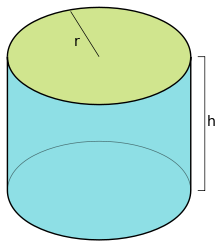You want to produce a cylindrical water container with a capacity of 350mL. What dimensions will minimize the amount of material required for the container? Round your answer to the nearest thousandth. Help!?
1 Answer
Hence we have a minimal surface area (amount of material when):
# "radius" = 0.0381911 ... (m) #
# "height" = 0.076382 ... (m)#
It isn't clear what units we should use, so I will omit rounding.
Explanation:
Let us set up the following variables:
# {(r, "Radius", (m)), (y, "Height of container", (m)), (A, "Surface Area of the container", (m^2)), (V, "Volume of the container", (m^3)) :} #
We want to vary the radius
Then the volume is fixed at
Volume of the container is:
# V = pir^2h = 0.00035 #
# => h = 0.00035/(pir^2) #
And, the Surface Area is given by:
# "Side" = 2pirh #
# "Top+Bottom"=2pir^2#
So, the surface area is:
# A= 2pirh + 2pir^2 #
And we can eliminate
# :. A = 2pir(0.00035/(pir^2)) + 2pir^2 #
# " " = 0.0007/(r) + 2pir^2 #
Differentiating wrt
# (dA)/(dr) = - 0.0007/r^2+4pir#
At a critical point,
# (dA)/(dr) = 0 => - 0.0007/r^2+4pir = 0 #
# :. 4pir = 0.0007/r^2 #
# :. r^3 = 0.0007/(4pi) #
# :. \ \ r = 0.0381911 ... (m) #
With
# A = 0.274932 ... (m^2)#
# h = 0.076382 ... (m)#
# V=0.00035 \ (m^3)#
We should check that this value leads to a minimum (rather than a maximum).
Differentiating the first derivative a second time:
# (d^2A)/(dr^2) = 0.0014/r^3+4pi#
# > 0 " when " r= 0.0381911 ...#
Hence we have a minimal surface area (amount of material when):
# "radius" = 0.0381911 ... (m) #
# "height" = 0.076382 ... (m)#


